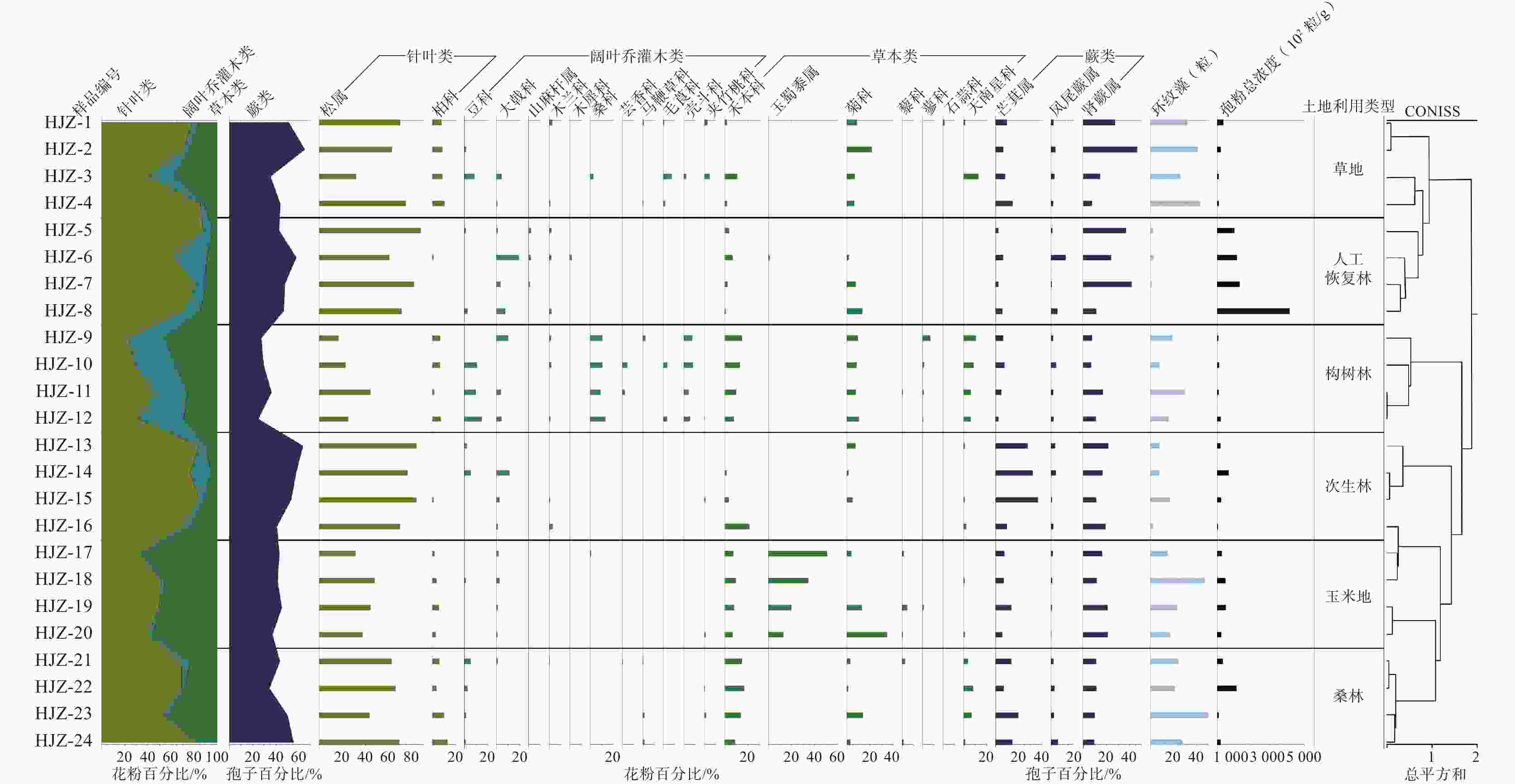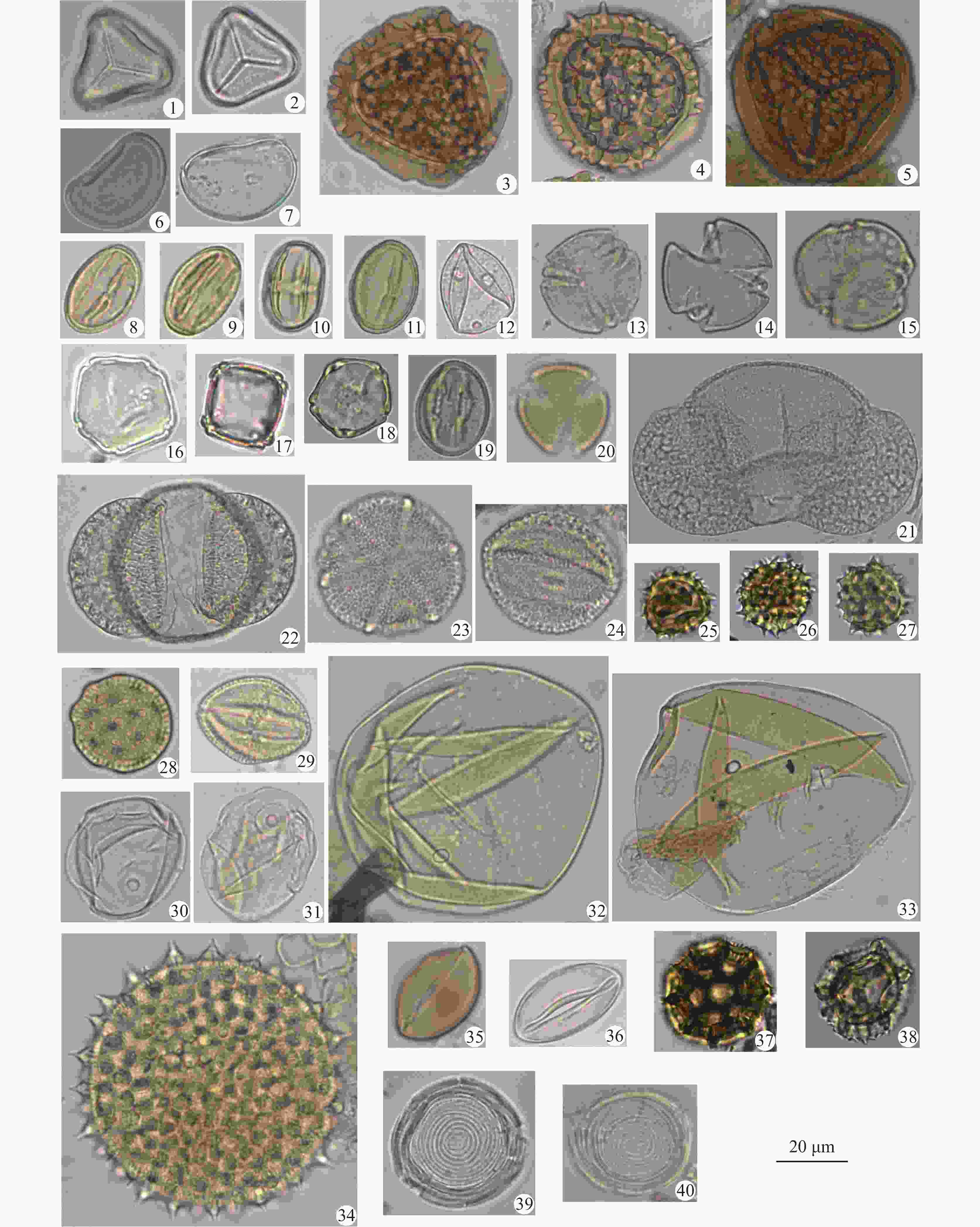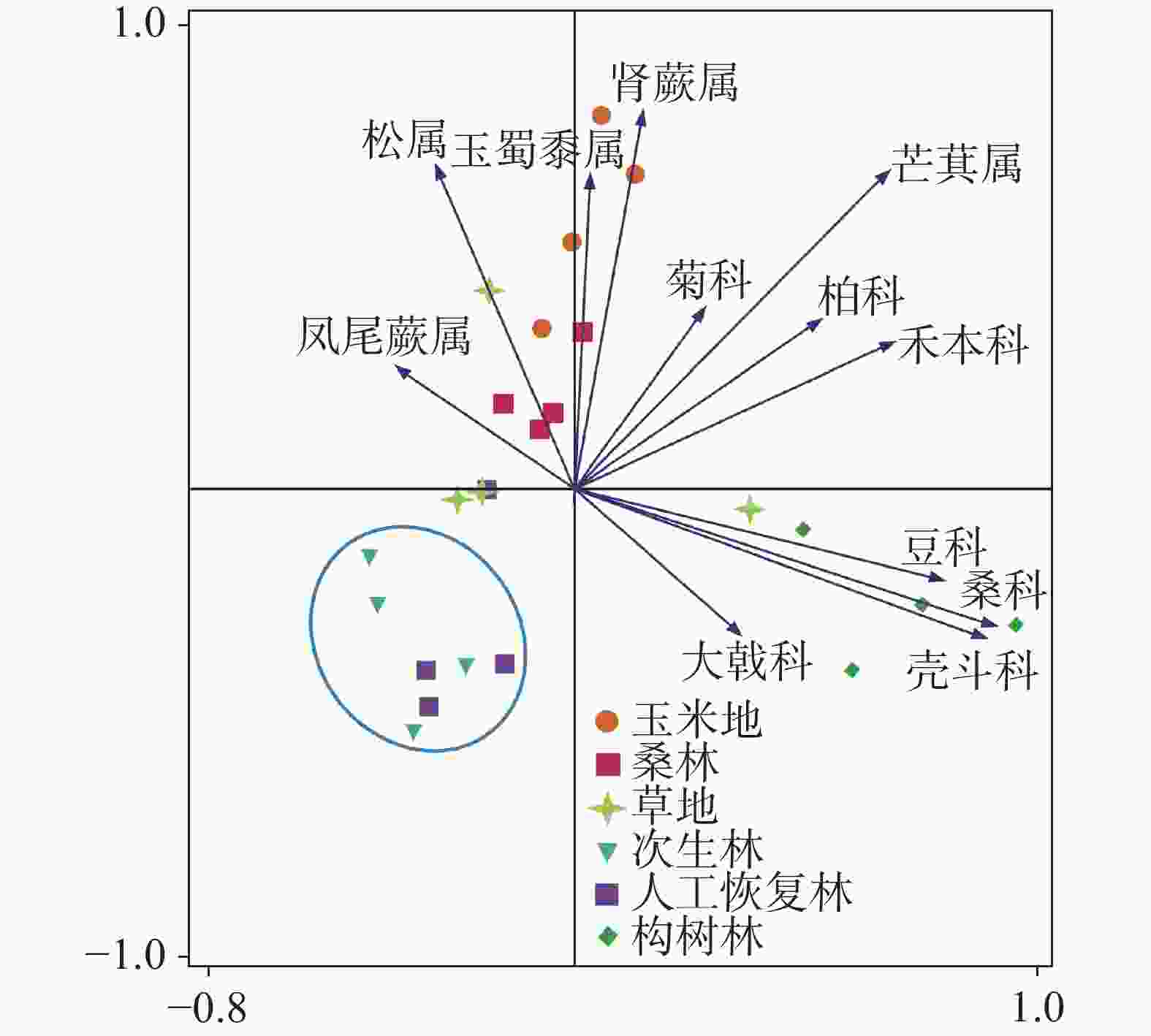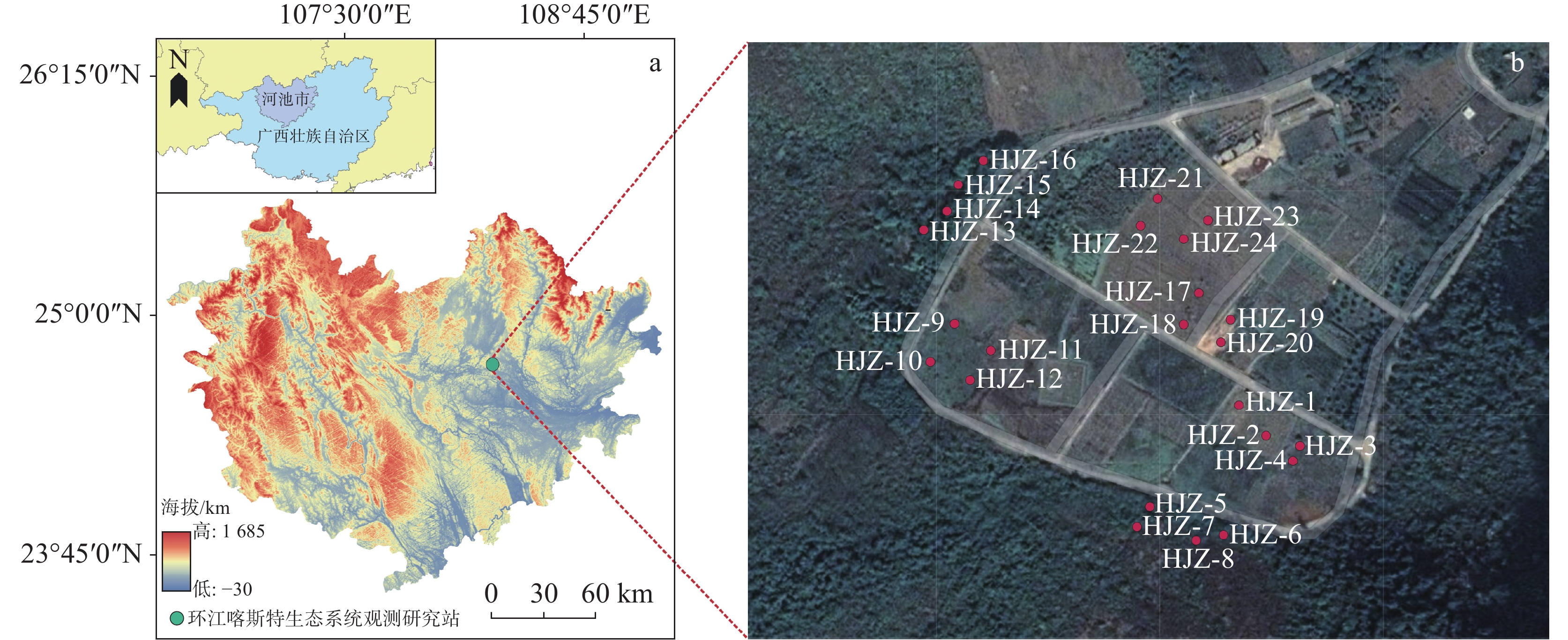Relationship between surface soil pollen and modern vegetation at the Guangxi Karst Huanjiang Observation Station
-
摘要: 厘清喀斯特地区表土孢粉与现代植被的关系是解译地层孢粉的基础,是恢复古环境的前提。文章通过对广西喀斯特环江观测站的24个表土和苔 藓样品进行分析,探讨其表土孢粉与现代植被的对应关系。结果表明:(1)共鉴定出49科/属孢粉类型,花粉组合中针叶类占优势,含量为32.49%~78.65%,其中以松属为主;其次为草本(9.41%~53.43%),以禾本科、菊科和玉蜀黍属为主;阔叶乔灌木类最低,含量为2.94%~33.49%,以豆科、大戟科、木兰科和桑科为主。表土花粉组合基本能反映环江站周围植被的总体特征;(2)草本花粉在玉米地含量最高(53.43%),主要以玉蜀黍属为主;次生林、草地、人工恢复林及桑林的蕨类孢子含量较高,分别达53.91%、49%、48.88%和46.04%;(3)PCA分析可较好区分草地、人工恢复林、构树林、次生林和玉米地,但桑林并不能很好地被区分,可能采样时间及其花粉保存条件等有关;(4)不同土地利用方式/植被类型间孢粉浓度差异显著,人工恢复林孢粉浓度最高,其他土地利用方式/植被类型的孢粉浓度依次为桑林>玉米地>次生林>草地>构树林,这可能与植被组成、土层扰动及孢粉保存条件等联系较大。Abstract:
This study takes surface pollen samples from different land use methods/vegetation types at the Huanjiang Observation and Research Station for Karst Ecosystems, Chinese Academy of Sciences (hereinafter referred to as the Huanjiang Station) as its research object. The Huanjiang station is located in the southern part of Huanjiang Maonan Autonomous County, Hechi City, Guangxi and represents typical karst peak cluster depression ecosystem in China. It is situated in the subtropical monsoon climate zone, with a mild climate and abundant rainfall throughout the county. The forest communities are primarily composed of evergreen broadleaf forests, followed by some deciduous broadleaf and mixed evergreen coniferous and broadleaf forests. The article aims to explore the characteristics of surface pollen assemblages under different land use methods/vegetation types at the Huanjiang Station, establish a correspondence between surface pollen and modern vegetation, so as to provide theoretical references for ecological restoration, Quaternary paleoenvironmental and paleoclimate reconstruction, and historical research on human interference activities in the study area and similar karst regions.All 24 topsoil and moss samples were prepared at the Key Laboratory of Environment Change and Resources Use in Beibu Gulf (Nanning Normal University), Ministry of Education, and then standard conventional acid-base methods to extract the pollen, that is weighing about 30 g of dry samples of topsoil samples and about 3 g of dry samples of moss samples. Add HCL to dissolve calcareous minerals, HF to digest silica, and several distilled water rinses. Finally, a 7 - μm nylon sieve was used to remove unwanted small particles, then collect the pollen to a 5 ml centrifuge tube. A pill of Lycopodium spores (10,315 grains/tablet) was added to each sample to calculate pollen concentration. The percentage of each pollen taxa is based on the total terrestrial pollen sum only, whereas that of spores is based on the sum of both pollen and spores. Pollen and spores were identified using a Leica DM4000 B microscope with 200/400x magnification. More than 300 pollen grains of per sample were counted. The programs Tilia (version 1.7.16) was used to construct the pollen diagrams. Using the Canoco (versions 5.0) software, principal component analysis (PCA) was applied to the pollen percentage data. The results show, (1) A total of 49 pollen taxa (genera or family)were identified from 24 topsoil (or moss) samples in the Huanjiang Station, 25 taxa belonged to trees and shrubs, there are mainly Pinus, Cupressaceae/ Taxodiaceae, Fabaceae, Euphorbiaceae, Magnoliaceae, Moraceae, among them, Pinus had the highest content (averaging 56.8% and reaching a maximum of 87.62%). And 20 taxa were Herbaceous, there are mainly Poaceae, Asteraceae, Araceae. The spores of ferns are mainly Nephrolepis, Dicranopteris and Pteris. In addition, freshwater algae ( Concentricystis ) spores also appeared in the samples.(2)There was a large difference in the concentration of topsoil pollen among different land use methods/vegetation types in the depression of Huanjiang Station, the lowest pollen concentration was 4,131 grains · g−1 in the topsoil samples of the secondary growth of forest, and the highest was 41, 6781 grains · g−1 in planted restoration forest. The average pollen concentration was relatively low, at 54,432 grains · g−1. There was a significant difference in the average concentrations of topsoil samples and moss samples, which were 27,371 grains · g−1 and 189,738 grains · g−1, respectively. Among all the samples, Pinus pollen had the highest concentration, reaching 19,232 · g−1, followed by Asteraceae ( 2,280 grains · g−1 ), Poaceae ( 1,535 grains · g−1 ) and Euphorbiaceae ( 1,461 grains · g−1 ). In addition, the spore concentration of ferns was relatively high, with an average of 6, 353 spores · g−1. (3)The result of principal component analysis ( PCA ) show that the pollen assemblage was well discrete and was heterogeneous, which could roughly achieve classification. Among different land use methods/vegetation types, corn fields correspond clearly with Zea, and coniferous woodland correspond clearly with Moraceae, enabling effective differentiation. Secondary growth of forest and planted restoration forest can be concentrated relatively well.The conclusion of this article is, (1)The topsoil pollen composition corresponds well with the vegetation types of each land use type/vegetation type and the combination of surface pollen can basically reflect the overall characteristics of vegetation around the depression. (2)PCA analysis can effectively distinguish grassland, planted restoration forest, coniferous woodland, secondary growth of forest, and cornfields, it shows that the surface pollen of different land use / vegetation types has obvious differentiation. However, mulberry forest cannot be well distinguished, which may be related to the fact that Morus sampling time and pollen preservation conditions.(3)The pollen concentrations of different land use methods/vegetation types are in the order of planted restoration forest > mulberry forests > cornfields > secondary growth of forest > grasslands > coniferous woodland, which may be closely related to vegetation composition, soil disturbance, and pollen preservation conditions. -
Key words:
- topsoil pollen assemblage /
- Huanjiang Station /
- karst /
- land use methods /
- vegetation types
-
表 1 表土样品采样点信息
Table 1. Topsoil sample sampling point information
土地利用方式/植被类型 样品编号 经度(E) 纬度(N) 海拔/m 样品类型 草地 HJZ-1 108°19′28″ 24°44′17″ 265 表土 HJZ-2 108°19′30″ 24°44′16″ 265 表土 HJZ-3 108°19′27″ 24°44′16″ 265 表土 HJZ-4 108°19′28″ 24°44′17″ 265 表土 人工恢复林 HJZ-5 108°19′19″ 24°44′15″ 280 苔藓 HJZ-6 108°19′22″ 24°44′13″ 280 苔藓 HJZ-7 108°19′21″ 24°44′14″ 280 苔藓 HJZ-8 108°19′21″ 24°44′16″ 280 苔藓 构树林 HJZ-9 108°19′21″ 24°44′19″ 265 表土 HJZ-10 108°19′22″ 24°44′18″ 265 表土 HJZ-11 108°19′21″ 24°44′18″ 265 表土 HJZ-12 108°19′22″ 24°44′19″ 265 表土 次生林 HJZ-13 108°19′21″ 24°44′21″ 283 表土 HJZ-14 108°19′21″ 24°44′21″ 285 表土 HJZ-15 108°19′22″ 24°44′21″ 283 表土 HJZ-16 108°19′22″ 24°44′23″ 284 表土 玉米地 HJZ-17 108°19′27″ 24°44′18″ 266 表土 HJZ-18 108°19′28″ 24°44′19″ 266 表土 HJZ-19 108°19′27″ 24°44′19″ 266 表土 HJZ-20 108°19′28″ 24°44′18″ 266 表土 桑林 HJZ-21 108°19′30″ 24°44′21″ 273 表土 HJZ-22 108°19′31″ 24°44′22″ 273 表土 HJZ-23 108°19′30″ 24°44′22″ 273 表土 HJZ-24 108°19′31″ 24°44′21″ 273 表土 -
[1] Sheng M Y, Xiong K N, Wang L J, Li X N, Li R, Tian X J. Response of soil physical and chemical properties to Rocky desertification succession in South China Karst[J]. Carbonates and Evaporites, 2018, 33: 15-28. doi: 10.1007/s13146-016-0295-4 [2] Green S M, Dungait J A J, Tu C L, Buss H L, Sanderson N, Hawkes S J, Xing F X, Yue F J, Hussey V L, Peng J, Johnes P, Barrows T, Hartley L P, Song X W, Jiang Z H, Meersmans J, Zhang X Y, Tian J, Wu X C, Liu H Y, Song Z L, Evershed R, Gao Y, Quine T A. Soil functions and ecosystem services research in the Chinese karst Critical Zone[J]. Chemical Geology, 2019, 527: 119107. doi: 10.1016/j.chemgeo.2019.03.018 [3] Peng S L, Chen A Q, Fang H D, Wu J L, Liu G C. Effects of vegetation restoration types on soil quality in Yuanmou dry-hot valley, China. Soil science and Plant Nutrition, 2013.59(3): 347.360. [4] 赵恬茵, 吴媛媛, 孙连群, 高长春, 潘网生, 许玉凤, 程富东. 岩溶地区水土漏失的定量研究进展[J]. 中国岩溶, 2023, 42(1): 61-70, 108. doi: 10.11932/karst20230105ZHAO Tianyin, WU Yuanyuan, SUN Lianqun, GAO Changchun, PAN Wangsheng, XU Yufeng, CHENG Fudong. Review of the quantitative study on soil leakage in karst area[J]. Carsologica Sinica, 2023, 42(01): 61-70, 108. doi: 10.11932/karst20230105 [5] 唐伟, 蓝高勇, 殷建军, 杨会, 吴夏. 桂林西北郊光明山峰丛坡地土壤210Pb与226Ra分布与迁移规律研究[J]. 中国岩溶, 2021, 40(5): 860-867. doi: 10.11932/karst2021y30TANG Wei, LAN Gaoyong, YIN Jianjun, YANG Hui, WU Xia. Distribution and migration of 210Pb and 226Ra in soil in of peak-cluster hillside of Guangming mountain, Guilin[J]. Carsologica Sinicat, 2021, 40(5): 860-867. doi: 10.11932/karst2021y30 [6] 覃星铭, 何丙辉, 沈利娜, 王魁, 喻崎雯, 张路遥. 漓江流域水土流失特征及其侵蚀影响因子典型分析[J]. 中国岩溶, 2018, 37(3): 351-360. doi: 10.11932/karst20180305QIN Xingming, HE Binghui, SHEN Lina, WANG Kui, YU Qiwen, ZHANG Luyao. Characteristics of soil and water loss in the Lijiang River Basin and soil erosion factors in typical karst small watersheds[J]. Carsologica Sinica, 2018, 37(3): 351-360. doi: 10.11932/karst20180305 [7] JIANG Z C, LIAN Y Q, QIN X Q. Rocky desertification in Southwest China: Impacts, causes, and restoration[J]. Earth-Science Reviews, 2014, 132: 1-12. doi: 10.1016/j.earscirev.2014.01.005 [8] 李旭尧, 邓艳, 曹建华, 蒋忠诚, 徐烨, 梁锦桃. 典型岩溶县生态承载力演变分析: 以云南泸西为例[J]. 中国岩溶, 2020, 39(3): 359-367. doi: 10.11932/karst2020y18LI Xuyao, DENG Yan, CAO Jianhua, JIANG Zhongcheng, XU Ye, LIANG Jintao. Evolution of ecological carrying capacity in typical karst counties: A case study of Luxi county, Yunnan Province[J]. Carsologica Sinica, 2020, 39(3): 359-367. doi: 10.11932/karst2020y18 [9] 裴广廷, 李夏, 贺同鑫, 黎俊, 庞榆, 胡宝清, 张伟东, 孙建飞. 广西喀斯特石漠化区不同植被恢复模式下土壤微生物多样性与群落结构特征及驱动因素分析[J]. 地理科学, 2024, 44(9): 1630-1642.PEI Guangyan, LI Xia, HE Tongxin, LI Jun, PANG Yu, HU Baoqing, ZHANG Weidong, SUN Jianfei. Characteristics of soil microbial diversity and community structure under different revegetation types in karst rocky desertification areas and analysis of driving factors[J]. Geographical Science, 2024, 44(9): 1630-1642. [10] 宁伟豪, 颜哲豪, 谌芸, 魏艳. 草本植物根系对喀斯特边坡浅层稳定性的影响[J]. 生态学报, 2024, 44(15): 6722-6730.NING Weihao, YAN Zhehao, CHEN Yun, WEI Yan. Effects of herbaceous plant roots on the stability of shallow layer on karst slopes[J]. Acta Ecologica Sinica, 2024, 44(15): 6722-6730. [11] 何茂林, 张玉珊, 高家勇, 吴清林, 李瑞. 喀斯特区土壤侵蚀与石漠化协同演变及交互关系[J]. 水土保持学报, 2023, 37(1): 140-150.HE Maolin, ZHANG Yushan, GAO Jiayong, WU Qinglin, LI Rui. Synergistic Evolution and Interaction of Soil Erosion and Rocky Desertification in Karst Arca[J]. Journal of Soil and Water Conservation, 2023, 37(1): 140-150. [12] 黄沛, 张雷一, 纪署光, 李卫, 姚斌, 郑广, 李昭. 喀斯特石漠化区林草间作对土壤养分及微生物数量的影响[J]. 草业科学, 2024, 41(7): 1549-1557. doi: 10.11829/j.issn.1001-0629.2023-0226HUANG Pei, ZHANG Leiyi, JI Shuguang, LI Wei, YAO Bin, ZHENG Guang, LI Zhao. Effects of forest-grass intercropping on soil nutrient and microbial populations in Karst rocky desertification areas[J]. Pratacultural Science, 2024, 41(7): 1549-1557. doi: 10.11829/j.issn.1001-0629.2023-0226 [13] 周玉琴, 赵筱青, 冉玉菊, 徐逸飞, 普军伟, 叶显民, 汪小宝, 王越男, 瞿国寻. 多情景下喀斯特山区土地利用对碳储量的影响[J]. 环境科学与技术, 2024, 47(8): 205-216.ZHOU Yuqin, ZHAO Xiaoqing, RAN Yuju, XU Yifei, PU Junwei, YE Xianmin, WANG Xiaobao, WANG Yuenan, QU Guoxun. Impact of Land Use on Carbon Storage in Karst Mountainous Areas Under Multiple Scenarios[J]. Environmental Science & Technology, 2024, 47(8): 205-216. [14] 张君, 陈洪松, 聂云鹏, 付智勇, 连晋姣, 王发, 罗紫东, 王克林. 西南喀斯特关键带结构及其水文过程研究进展[J]. 应用生态学报, 2024, 35(4): 985-996.ZHANG Jun, CHEN Hongsong, NIE Yunpeng, FU Zhiyong, LIAN Jinjiao, WANG Fa, LUO Zidong, WANG Kelin. Research progress on structure and hydrological processes in the karst critical zone of southwest China[J]. Chinese Journal of Applied Ecology, 2024, 35(4): 985-996. [15] 王开发, 王宪曾. 粉学概论[M]. 北京: 北京大学出版社, 1983.WANG Kaifa, WANG Xianzeng. Theory of pollen analysis[M]. Beijing: Peking University Press, 1983. [16] 宋长青, 孙湘君. 花粉—气候因子转换函数建立及其对古气候因子定量重建[J]. Acta Botanica Sinica, 1997, 39(6): 554-560.SONG Changqing, SUN Xiangjun. Establishment of transfer functions of the pollen-climatic factors in Northern China and the quant-itative climatic reconstruction at DJ Core[J]. Acta Botanica Sin-ica, 1997, 39(6): 554-560. [17] Takeshi N, Hiroyuki K, Yoshinori Y, Pavel E. T, Kotoba N, Katsuya G, Yuki S, and Yangtze R C P M. Asynchronous climate changes in the North Atlantic and Japan during the last termination[J]. Science, 2003, 299(5607): 688-691. doi: 10.1126/science.1078235 [18] Zhao Y, Yu Z, Zhao W. Holocene vegetation and climate histories in the eastern Tibetan Plateau: controls by insolation-driven temperature or monsoon-derived precipitation changes?[J]. Quaternary Science Reviews, 2011, 30(9-10): 1173-1184. doi: 10.1016/j.quascirev.2011.02.006 [19] 袁新田, 谢世友. 重庆金佛山国家自然保护区山顶与山坡表土孢粉对比研究[J]. 山地学报, 2012, 30(6): 655-662. doi: 10.3969/j.issn.1008-2786.2012.06.003YUAN Xintian, XIE Shiyou. A comparative study on surface spore-pollen in the mountaintop and mountainside of Mt. Jinfo nature reserve, Chongqing, China[J]. Mountain Research, 2012, 30(6): 655-662. doi: 10.3969/j.issn.1008-2786.2012.06.003 [20] 谭金凤, 肖霞云, 李艳玲, 罗俊. 云南省香格里拉地区现代孢粉与植被关系研究[J]. 微体古生物学报, 2020, 37(1): 68-81.TAN Jinfeng, XIAO Xiayun, LI Yanling, LUO Jun. Relationship between modern vegetation and pollen assembalges in the Shangri-La area, Yunnan Province[J]. Acta Micropalaeontologica Sinica, 2020, 37(1): 68-81. [21] 汪啟容, 蒋勇军, 郝秀东, 马丽娜, 张彩云, 秦琳娟, 郑旸, 邱华. 重庆中梁山岩溶槽谷区表土孢粉与现代植被的关系研究[J]. 中国岩溶, 2021, 40(3): 466-475.WANG Qirong, JIANG Yongjun, HAO Xiudong, MA Lina, ZHANG Caiyun, QIN Linjuan, ZHENG Yang, QIU Hua. Relationship between surface soil pollen and modern vegetation in karst trough area of Zhongliang mountain, Chongqing City, SW China[J]. Carsologica Sinica, 2021, 40(3): 466-475. [22] 吴亮君, 王璞珺, 张晶, 辛存林, 容悦冰, 陈伟海, 张远海, 黄超. 典型岩溶高原边缘夷平面沉积特征及古气候环境: 以湘西洛塔及贾坝剖面为例[J]. 中国岩溶, 2024, 43(2): 239-271.WU Liangjun, WANG Pujun, ZHANG Jing, XIN Cunlin, RONG Yuebing, CHEN Weihai, ZHANG Yuanhai, HUANG Chao. Sedimentary and palaeoclimatic characteristics of planation surface at the edge oftypical karst plateau: A case study of Luota and Jiaba sctions in Xiangxi[J]. Carsologica Sinica, 2024, 43(2): 239-271. [23] 黄明, 马春梅, 何锟宇, 唐淼, 徐佳佳, 朱诚. 成都平原宝墩遗址中晚全新世孢粉记录的环境变迁及人类活动[J]. 第四纪研究, 2022, 42(4): 1078-1093. doi: 10.11928/j.issn.1001-7410.2022.04.12HUANG Ming, MA Chuanmei, HE Kunyu, TANG Miao, XU Jiajia, ZHU Cheng. Environmental changes and human activities recorded by the pollen in the Middle-Late Holocene at Baodun Site, Chengdu Plain[J]. Quaternary Sciences, 2022, 42(4): 1078-1093. doi: 10.11928/j.issn.1001-7410.2022.04.12 [24] 石胜强, 袁道先, 罗伦德, 赵增友, 郝秀东. 35000 a BP以来四川洪雅的孢粉记录与气候变化[J]. 中国岩溶, 2012, 31(2): 121-130. doi: 10.3969/j.issn.1001-4810.2012.02.003SHI Shengqiang, YUAN Daoxian, LUO Lunde, ZHAO Zengyou, HAO Xiudong. Sporopollen records and climate changes since 35 000 a BP in Hongya, Sichuan Province[J]. Carsologica Sinica, 2012, 31(2): 121-130. doi: 10.3969/j.issn.1001-4810.2012.02.003 [25] 李立学, 郝秀东, 欧阳绪红, 薛美玲, 劳月英, 秦琳娟, 韦嘉胜. 桂西北喀斯特峰丛洼地区表土孢粉与现代植被关系研究: 以环江县蒙峒洼地为例[J]. 地理科学, 2023, 43(11): 2060-2068.LI Lixue, HAO Xiudong, OUYANG Xuhong, XUE Meiling LAO Yueying QIU Linjuan, WEI Jiasheng. Relationship between topsoil sporopollen and modern vegetation in karst peak-cluster depression in northwest of Guangxi: A case in Mengtong depression, Huanjiang County[J]. Scientia Geographica Sinica, 2023, 43(11): 2060-2068. [26] 孙香萱. 荔波—环江喀斯特世界自然遗产景观生态风险评价及生态安全格局优化[D]. 贵阳: 贵州师范大学, 2024.SUN Xiangxuan. Ecological risk assessment and optimization of ecological safety pattern of libo-huanjiang karst world natural heritage landscape[D]. Guiyang: Guizhou Normal University, 2024. [27] 朱晓锋, 陈洪松, 付智勇, 王克林, 张伟, 徐勤学, 方荣杰. 喀斯特灌丛坡地土壤-表层岩溶带产流及氮素流失特征[J]. 应用生态学报, 2017, 28(7): 2197-2206.ZHU Xiaofeng, CHEN Hongsong, FU Zhiyong, WANG Kelin, ZAHNG Wei, XU Qinxue, FANG Rongjie. Runoff and nitrogen loss characteristics in soil-epikarst system on a karst shrub hillslope[J]. Chinese Journal of Applied Ecology, 2017, 28(7): 2197-2206. [28] Zhang W, Zhao J, Pan F J , Li D, Chen H S, Wang K L. Changes in nitrogen and phosphorus limitation during secondary succession in a karst region in southwest China[J]. Plant and Soil, 2015, 391(1): 77-91. [29] Faegri K, Kaland P E, Krzywinski K. Textbook of Pollen Analysis[J]. Journal of Biogeography, 1989, 12(12): 328. [30] 李永飞, 李春海, 许斌, 舒军武, 李月丛, 许清海. 苏鲁人类扰动区表土花粉组合与植被关系的研究[J]. 地球科学进展, 2019, 34(4): 333-345.LI Yongfei, LI Chunhai, XU Bin, SHU Junwu, LI Yuecong, XU Qinghai. Modern Pollen Assemblages from Human-Influenced Vegetation in Eastern China and Their Spatial Changes[J]. Advances in Earth Science, 2019, 34(4): 333-345. [31] 王伏雄, 钱南芬, 张玉龙, 杨惠秋. 中国植物花粉形态(第二版)[M]. 北京: 科学出版社. 1995.WANG Fuxiong, QIAN Nanfen, ZHANG Yulong, YANG Huiqiu. Pollen Morphology of Chinese Plants (Second Edition) [M]. Beijing: Science Press , 1995. [32] 唐领余, 毛礼米, 舒军武, 李春海, 沈才明, 周忠泽. 中国第四纪孢粉图鉴[M]. 北京: 科学出版社, 2016.TANG Lingyu, MAO Limi, SHU Junwu, LI Chunhai, SHEN Caiming, ZHOU Zhongze. Chinese Quaternary Spore Atlas [M]. Beijing: Science Press, 2016. [33] 郝秀东, 欧阳绪红, 谢世友, 石胜强, 李林立, 罗伦德. 典型喀斯特石漠化地区表土孢粉与现代植被关系[J]. 地理科学, 2011, 31(6): 758-763.HAO Xiudong, OUYANG Xuhong, XIE Shiyou, SHI Shengqiang, LI Linli, LUO Lunde. The relationship between pollen assemblages in topsoil and modern vegetation in the typical karst rocky desertification area[J]. Scientia Geographica Sinica, 2011, 31(6): 758-763. [34] 汪啟容, 蒋勇军, 郝秀东, 乔伊娜, 张彩云, 马丽娜, 茆杨, 吕同汝, 邱菊. 孢粉记录的重庆岩溶槽谷区700年来植被演替与喀斯特石漠化[J]. 生态学报, 2021, 41(9): 3634-3644.WANG Qirong, JIANG Yongjun, HAO Xiudong, QIAO Yina, ZHANG Caiyun, MA Lina, MAO Yang, LV Tongnu, QIU Ju. A 700-year record of vegetation and rocky desertification evolution based on palynological data of the karst valley area, Chongqing City, China[J]. Acta Ecologica Sinica, 2021, 41(9): 3634-3644. [35] Conner J K. The Natural History of Pollination[J]. Ecology, 1997, 78(1): 327-329. [36] 李欣怡, 向建军, 李永飞, 李蓓蓓, 夏仕榕, 谷雨, 廖博儒, 廖艳艳. 湖南八大公山表土孢粉组合及其植被指示意义[J/OL]. 生态学报, 2025, (9): 1-202025-04-05]. https: //doi. org/10.20103/j. stxb. 202406231453. LI Xinyi, XIANG Jianjun, LI Yongfei, LI Beibei, XIA Shirong, GU Yu, LIAO Boru, LIAO Yanyan. Surface pollen assemblages and their vegetation indicating significance in Badagong Mountains, Hunan Province, China[J]. Acta Ecologica Sinica, 2025(9): 1-20[2025-04-05]. https://doi.org/10. 20103/j.stxb. 202406231453. [37] Liu L, Shen X T, Chen X P, Fan X M and Chen R F. Pollen Morphology and Taxonomic Significance of Chinese Morus L[J]. Applied Mechanics and Materials, 2014, 618: 344-348. doi: 10.4028/www.scientific.net/AMM.618.344 [38] 阮蓓. 茧丝织就脱贫致富路: 广西环江毛南族自治县高质量发展桑蚕产业纪实[N]. 农民日报, 2020-07-17. http://nynct.gxzf.gov.cn/xwdt/gxlb/gx/t5747246.shtml.RUAN Bei. Cocoons and silk weave the way out of poverty and become rich - Chronicle of high-quality development of mulberry silkworm industry in Guangxi Huanjiang Maonan Autonomous County[N]. Farmers' Daily, 2020-07-17. http://nynct.gxzf.gov.cn/xwdt/gxlb/gx/t5747246.shtml. [39] 张雄, 戴林桐, 邹森, 卿丽华. 攀枝花城市气传花粉现状及与过敏性鼻炎发生的相关性分析[J]. 实用预防医学, 2023, 30(11): 1325-1329. doi: 10.3969/j.issn.1006-3110.2023.11.011ZHANG Xiong, DAI Lintong, ZOU Sen, QING Lihua. Current situation of airborne pollen and its correlation with allergic rhinitis in urban area of Panzhihua City[J]. Practical Preventive Medicine, 2023, 30(11): 1325-1329. doi: 10.3969/j.issn.1006-3110.2023.11.011 [40] 郝秀东, 欧阳绪红, 郑丽波, 钟华, 汪美芳. 浙江嵊州西白山表土花粉的初步研究[J]. 地理科学, 2020, 40(6): 1010-1018.HAO Xiudong, OUYANG Xuhong, ZHENG Libo, ZHONG Hua, WANG Meifang. Pre-liminary pollen analysis of surface samples from the Xibai Moutain in Shengzhou City, Zhejiang Province[J]. Scientia Geographica Sinica, 2020, 40(6): 1010-1018. [41] 伍婧, 马玉贞, 桑艳礼, 蒙红卫, 胡彩莉. 宁夏大罗山表土样品中主要花粉类型的代表性[J]. 古生物学报, 2013, 52(1): 57-67.WU Jing, MA Yuzhen, SANG Yanli, MENG Hongwei, HU Caili. Representation of major pollen taxa from surface samples of Daluoshan Mountain, Ningxia[J]. Acta Palaeontologica Sinica, 2013, 52(1): 57-67. [42] 张雷. 广西环江发现极危新物种广西黄金柏[EB/OL]. 中国绿色时报, 2024 - 12 - 25 [2025 - 04 - 13]. http://forestry.gov.cn/c/www/zhzs/602023.jhtml.ZHANG Lei. New critically endangered species of Guangxi golden cypress discovered in Huanjiang, Guangxi Province, China[EB/OL]. China Green Times. 2024 - 12 - 25 [2025 - 04 - 13]. http://forestry.gov.cn/c/www/zhzs/602023.jhtml. [43] 谭伟芬, 欧继革, 卢国伍. 环江县林业外来有害病虫种类发生现状及防控对策[J]. 南方农业, 2024, 18(6): 215-217.TAN Weifen, OU Jige, LU Guowu. Current situation and prevention and control strategies of foreign harmful pests and diseases in forestry in Huanjiang County[J]. South China Agriculture, 2024, 18(6): 215-217. [44] 杜昌军, 李平, 黄瑞春, 贾松林, 王承南, 向云艳. 湘西喀斯特地区6种柏科植物生长情况调查分析[J]. 中南林业科技大学学报, 2015, 35(9): 109-112.DU Changjun, LI Ping, HUANG Ruichun, JIA Songlin, WANG Chengnan, XIANG Yunyan. Investigation and analysis on 6 species of Cupressaceae plants growing in karst area of Xiangxi Autonomous Prefecture[J]. Journal of Central South University of Forestry & Technology, 2015, 35(9): 109-112. [45] 王百竹, 白建华, 萨拉, 王丹雨, 杨晓晖, 朱媛君, 时忠杰. 呼伦贝尔沙化草地不同放牧潜力阶段群落特征[J]. 中国沙漠, 2025, 45(02): 205-216.WANG Baizhu, BAI Jianhua, SA La, WANG Danyu, YANG Xiaohui, ZHU Yuanjun, SHI Zhongjie. Characteristics of communities at different grazing potential in Hulun Buir sandy grassland[J]. Journal of Desert Research, 2025, 45(02): 205-216. [46] 高儒学, 戴全厚, 伍小涛, 魏志龙, 雷德雨. 喀斯特区土石工程堆积体坡面植被恢复评价[J]. 水土保持研究, 2024, 31(5): 45-52, 63.GAO Ruxue, DAI Quanhou, WU Xiaotao, WEI Zhilong, LEI Deyu. Assessment on Vegetation Restoration on the Slope Surface of Accumulation Body of Earth-rock Mixing Engineering in Karst area[J]. Research of Soil and Water Conservation, 2024, 31(5): 45-52, 63. [47] 郝秀东, 谢世友, 欧阳绪红, 罗伦德, 石胜强, 李林立, 孙爱芝, 赵增友. 岩溶石漠化区不同植被类型表土孢粉组合特征: 以重庆市南川区南平镇石漠化区为例[J]. 中国岩溶, 2010, 29(3): 301-311. doi: 10.3969/j.issn.1001-4810.2010.03.013HAO Xiudong, XIE Sheyou, OUYANG Xuhong, LUO Lunde, SHI Shengqiang, LI Linli, SUN Aizhi, ZHAO Zengyou. Features of spore-pollen assemblage in topsoil under different vegetation types in karst desert-A case in Nanping Town, Nanchuan District, Chongqing[J]. Carsologica Sinica, 2010, 29(3): 301-311. doi: 10.3969/j.issn.1001-4810.2010.03.013 [48] 舒军武, 王希华, 秦际威, 王伟铭. 浙江宁波天童山国家森林公园表土花粉初步分析[J]. 微体古生物学报, 2010, 27(3): 253-262.SHU Junwu, WANG Xihua, QIN Jiwei, WANG Weiming. Preliminary pollen analysis of surface samples from the Tiantongshan national forest park in Ningbo, Zhejiang province, East china[J]. Acta Micropalaeontologica Sinica, 2010, 27(3): 253-262. [49] 于俊杰, 彭博, 兰佑, 武彬, 王继龙, 丁大林, 劳金秀, 李帅丽, 戴璐. 孢粉证据揭示MIS5a以来福建东北沿海地区人类活动、海平面及气候变化[J]. 地球科学, 2021, 46(1): 281-292.YU Junjie, PENG Bo, LAN You, WU Bin, WANG Jilong, DING Dalin, LAO Jinxiu, LI Shaili, DAI Lu. Palynological Record Revealed Anthropogenic Deforestation, Sea Level and Climate Changes since Marine Isotope Stage 5a in the Northeastern Coast of Fujian Province[J]. Earth Science, 2021, 46(1): 281-292. [50] Cheng Z, Weng C, Steinke S, et al. Anthropogenic modification of vegetated landscapes in southern China from 6, 000 years ago[J]. Nature Geoscience, 2018, 11(12): 939-943. doi: 10.1038/s41561-018-0250-1 [51] 路晶芳, 刘健, 胡刚, 黄威, 王红, 张道来. 现代黄河三角洲北岸1.9Ma以来孢粉组合及古环境变化[J]. 沉积学报, 2022, 40(5): 1335-1345.LU Jingfang, LIU Jian, HU Gang, HUANG Wei, WANG Hong, ZAHNG Daolai. Pollen Assemblages and Induced Palaeoenvironmental Changes in the Yellow River Delta Since 1.9 Ma[J]. Acta Sedimentologica Sinica, 2022, 40(5): 1335-1345. [52] 李丽, 赵东海, 何莉, 彭友林, 王云. 太阳山地区蕨类植物资源调查[J]. 草业科学, 2014, 31(4): 621-626.LI Li, ZHAO Donghai, HE Li, PENG Youlin, WANG Yun. Investigation of ferns in Taiyangshan area[J]. Pratacultural Science, 2014, 31(04): 621-626. [53] 杨秀云, 顾思思, 曹晔, 郭芳, 尹大芳. 太原市城市绿地地被植物资源和园林应用[J]. 草原与草坪, 2014, 34(3): 54-61. doi: 10.3969/j.issn.1009-5500.2014.03.012YANG Xiuyun, GU Sisi, CAO Ye, GUO Fang, YIN Dafang. Groundcover plants resources and utilization in Taiyuan[J]. Grassland and Turf, 2014, 34(3): 54-61. doi: 10.3969/j.issn.1009-5500.2014.03.012 [54] 蒋梦姣. 滇西南现代花粉—植被/气候关系[D]. 昆明: 云南师范大学, 2019.JIANG Mengjiao. Modern pollen-vegetation/climate relationships in southwestern Yunnan[D]. Kunming: Yunnan Normal University, 2019 [55] Rasanen S, Hicks S, Odgaard B V. Pollen deposition in mosses and in a modified 'Tauber trap' from Hailuoto, Finland: what exactly do the mosses record[J]. Review of Palaeobotany and Palynology, 2004, 129(1/2): 103-116. [56] 郝秀东, 欧阳绪红, 谢世友, 魏兴萍. 重庆喀斯特地区现代花粉组合与植被的关系[J]. 生态学报, 2020, 40(15): 5266-5276.HAO Xiudong, OUYANG Xuhong, XIE Shiyou, WEI Xingping. Modern palynomorph assemblages and their relationships with vegetation in karst areas of Chongqing, Southwestern China[J]. Acta Ecologica Sinica, 2020, 40(15): 5266-5276. -




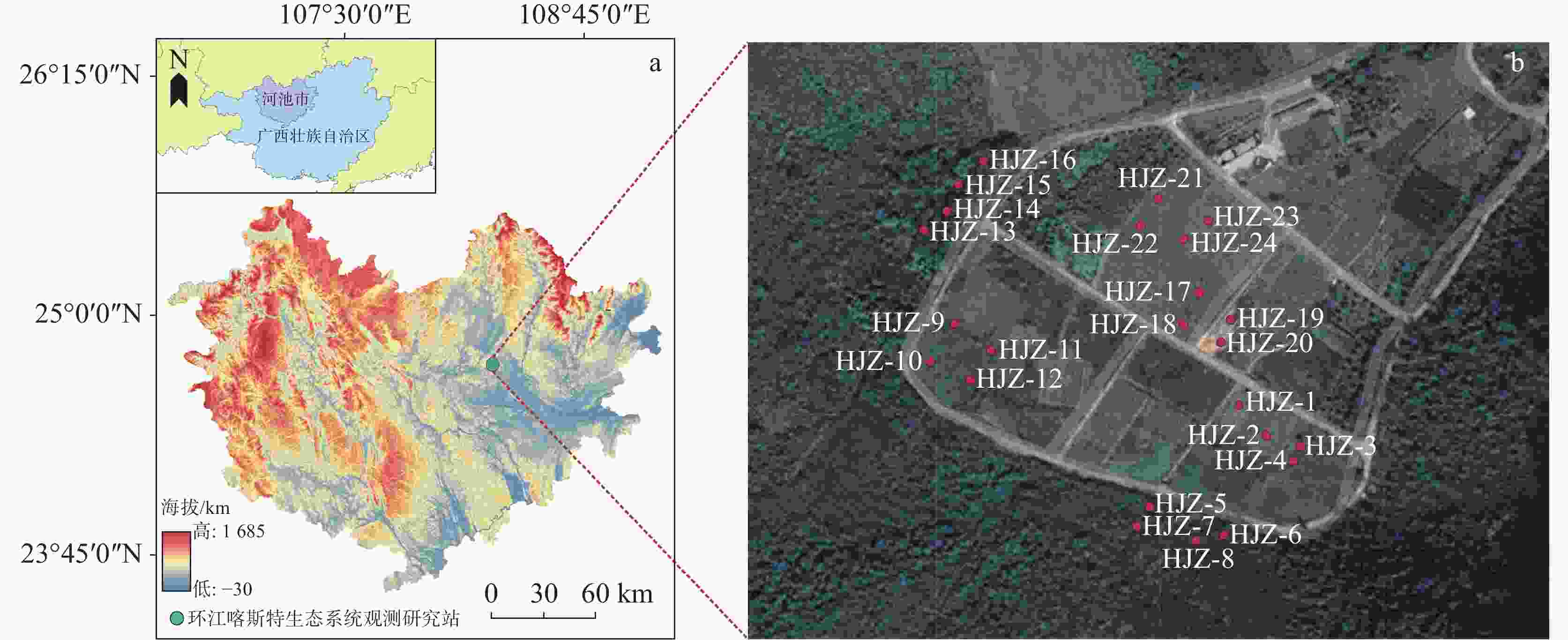
 下载:
下载:
